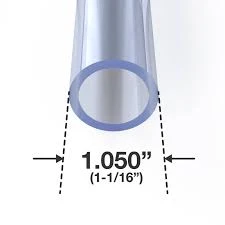Nov . 21, 2024 09:54 Back to list
dwc hdpe pipe
Understanding DWC HDPE Pipes An Overview
DWC HDPE (Double Wall Corrugated High-Density Polyethylene) pipes have gained significant traction in various industrial applications due to their superior performance characteristics and environmental benefits. These pipes are primarily utilized for drainage, sewage management, and stormwater applications, presenting a viable alternative to the traditional pipes made from concrete or metal.
Structure and Design
The design of DWC HDPE pipes is one of their most notable features. The double wall structure consists of an outer corrugated layer that provides strength and flexibility, combined with a smooth inner wall that facilitates efficient fluid flow. This unique structure not only enhances the durability of the pipes but also their resistance to various environmental factors such as soil movement, temperature fluctuations, and corrosive substances.
The corrugated exterior allows for easy installation, as the lightweight nature of HDPE reduces the handling challenges often encountered with heavier materials. The pipes are available in a range of diameters, making them suitable for various tasks, from small residential drainage installations to large-scale municipal sewage systems.
Advantages of DWC HDPE Pipes
1. Corrosion Resistance Unlike metal pipes, which can corrode over time, HDPE pipes are resistant to chemical attacks, thus prolonging their lifespan and reducing maintenance costs. This attribute is especially crucial in applications where the transported fluids may be corrosive.
2. Hydraulic Efficiency The smooth inner surface of DWC HDPE pipes ensures optimal flow characteristics, reducing friction losses and minimizing energy consumption in pumping applications. This efficiency also contributes to lower operational costs over the pipe's lifecycle.
dwc hdpe pipe

3. Environmental Impact HDPE is a recyclable material, and its production has a lower environmental impact compared to other pipe materials. The use of DWC pipes also promotes sustainable practices in drainage and sewage management, as they help in controlling stormwater runoff and mitigating flooding.
4. Installation Advantages The lightweight design of these pipes allows for quicker and easier handling and installation. This not only saves labor costs but also reduces the overall time required to complete projects.
5. Flexibility and Adaptability DWC HDPE pipes can withstand varying soil conditions and can easily be adapted to different installation environments. Their flexibility makes them less prone to damage from ground movement, a common challenge in many regions.
Applications
DWC HDPE pipes are widely used in various applications including
- Stormwater Management Efficiently managing runoff and reducing the risk of flooding. - Sewage and Wastewater Systems Providing reliable conveyance of sewage, reducing the risk of leaks and contamination. - Drainage Systems Facilitating the removal of excess water from both urban and rural areas.
Conclusion
In conclusion, DWC HDPE pipes stand out as a modern solution for numerous piping challenges in drainage and wastewater management. Their remarkable durability, efficiency, and ease of installation make them a preferred choice for engineers and contractors alike. As industries increasingly shift towards sustainable practices, the adoption of DWC HDPE pipes is likely to continue growing, reinforcing their role as a crucial component in modern infrastructure development.
-
High-Quality PPR Pipes and Fittings Durable ERA PPR & PVC PPR Solutions
NewsJul.08,2025
-
Black HDPE Cutting Board - Durable, Non-Porous & Food Safe HDPE Plastic Cutting Board
NewsJul.08,2025
-
High-Quality CPVC Panel Durable HDPE & PVC Panels Supplier
NewsJul.08,2025
-
Double PE Welding Rod Supplier - High Strength, Durable & Versatile Welding Solutions
NewsJul.07,2025
-
High-Quality PVC-O Pipe Supplier Durable 75mm PVC Pipe & Connections Leading PVC Pipe Company
NewsJul.07,2025
-
HDPE Drainage Pipe Supplier – Durable & Corrosion-Resistant Solutions
NewsJul.06,2025

